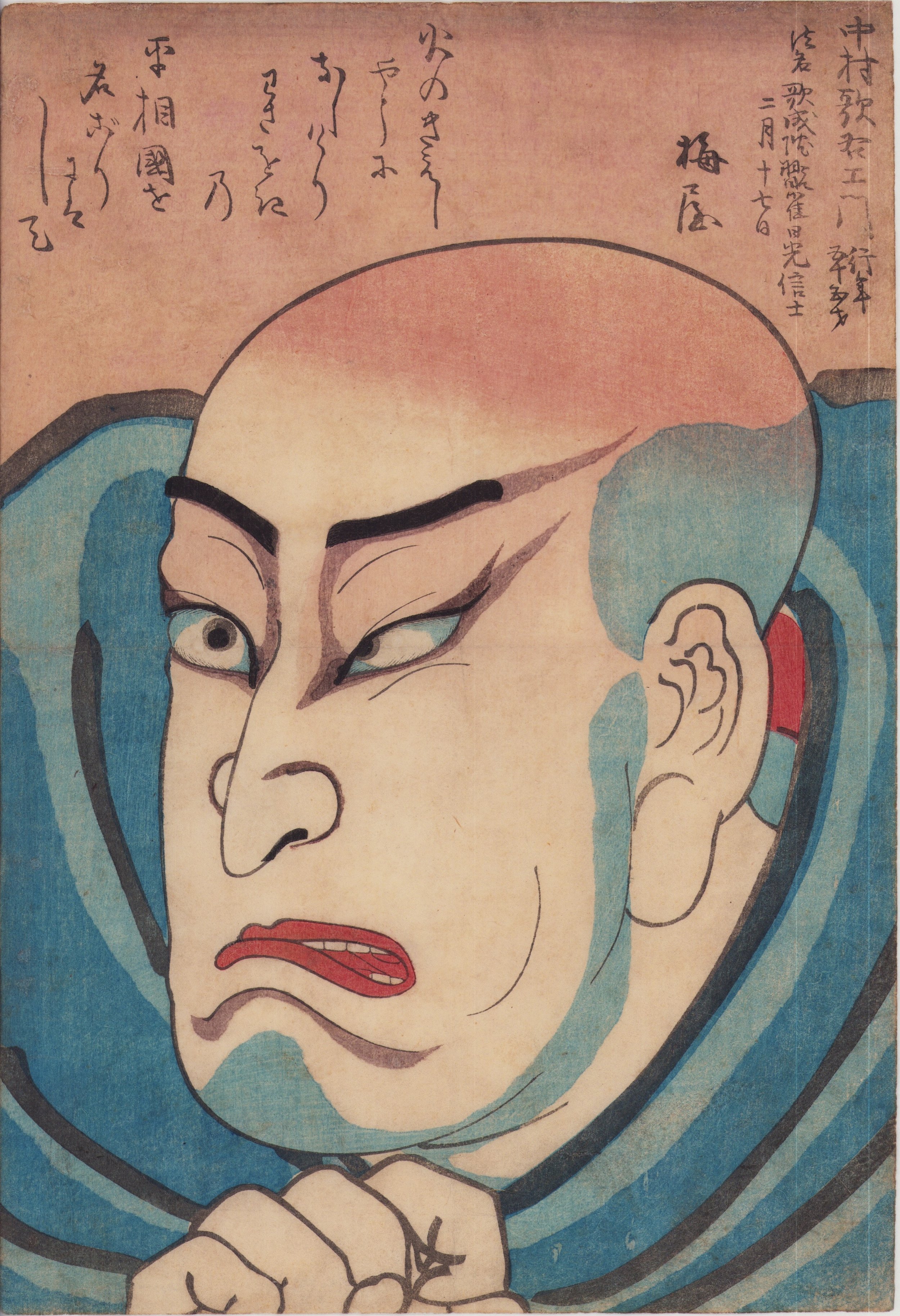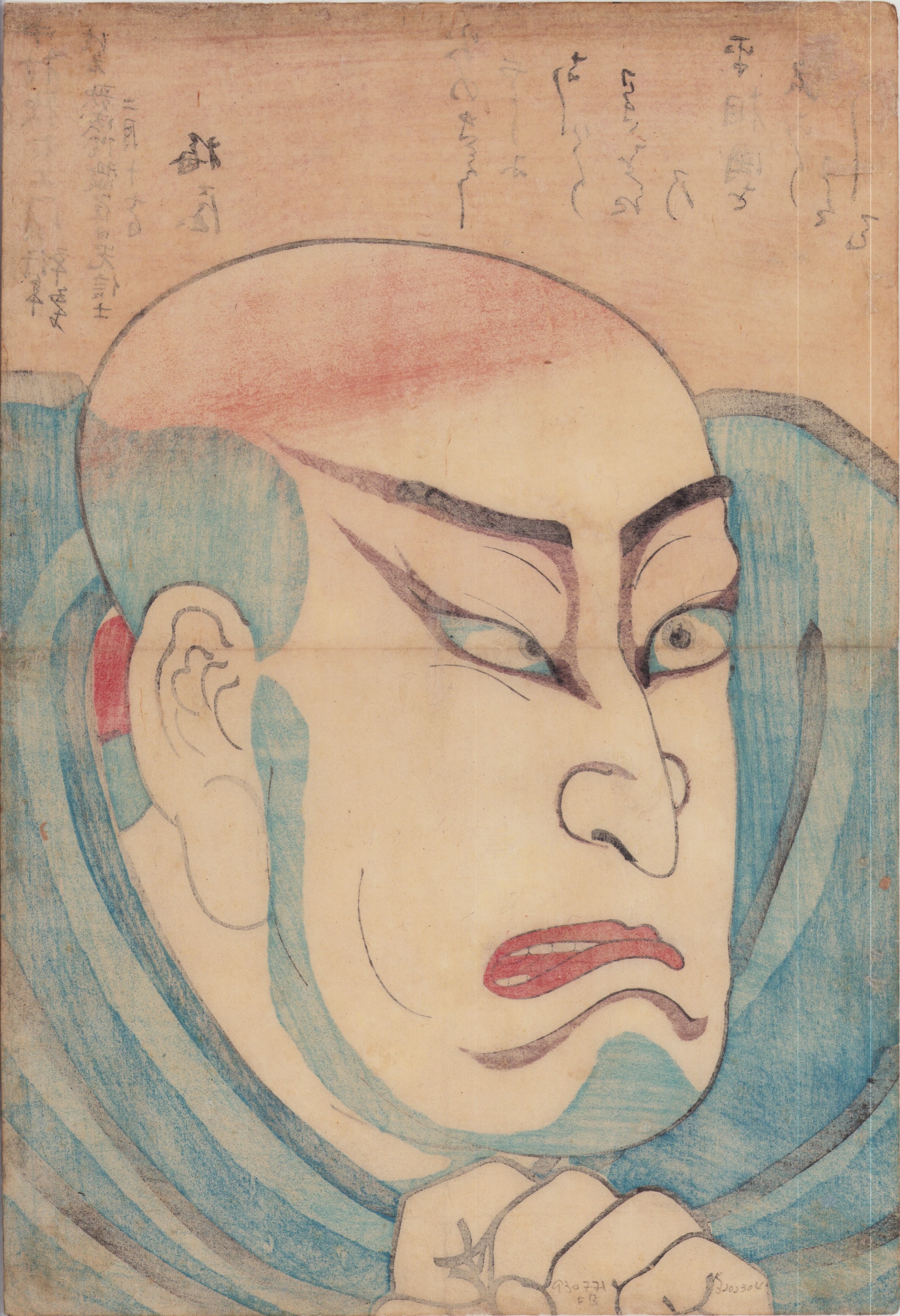Kuniyoshi | Nakamura Utaemon IV in the role of Taira no Kiyomori
歌川国芳 Utagawa Kuniyoshi (1798–1861)
四代目中村歌右卫门之死绘
Nakamura Utaemon IV in the role of Taira no Kiyomori
1852
木版画 | 纵绘大判 | 36cm x 24.5cm
Woodblock-print | Oban tata-e | 36cm x 24.5cm
颜色保存完好;边缘经修剪;有中间折痕
Good color; trimmed; centrefold
死绘,是一类于歌舞伎役者去世时发行的肖像画,创作年代多集中于江户时代末期。其画面内容除包含役者肖像外,还通常载有逝世日期、戒名、墓所、追思诗句等信息,不仅颇具艺术收藏价值,对于民俗学、宗教学及歌舞伎等领域的研究者而言也是极为宝贵的参考资料。
四代目中村歌右卫门(1798-1852),本名平野吉太郎,江户时代的著名歌舞伎役者,三代目中村歌右卫门(1778-1838)之养子。他身材高大,五官标致,舞技出众,在很多方面都青出于蓝,较三代目强出不少。本作中,将一生奉献给艺界的他即使已身着一袭象征死亡的水蓝色外套,仍扮演着平相国平清盛(1118-1181)的模样,双眉上扬,嘴角下撇,两眼圆睁呈“见得”状,与平日里的舞台形象无二。在画面的左上方,写有一首由狂歌师梅屋鹤寿(1801-1865)创作的纪念性短歌,中文大意如下:
如火般熄灭
莫可奈何
我们将永远铭记
他扮演的平相国
Interested in purchasing?
Please contact us.
歌川国芳 Utagawa Kuniyoshi (1798–1861)
四代目中村歌右卫门之死绘
Nakamura Utaemon IV in the role of Taira no Kiyomori
1852
木版画 | 纵绘大判 | 36cm x 24.5cm
Woodblock-print | Oban tata-e | 36cm x 24.5cm
颜色保存完好;边缘经修剪;有中间折痕
Good color; trimmed; centrefold
死绘,是一类于歌舞伎役者去世时发行的肖像画,创作年代多集中于江户时代末期。其画面内容除包含役者肖像外,还通常载有逝世日期、戒名、墓所、追思诗句等信息,不仅颇具艺术收藏价值,对于民俗学、宗教学及歌舞伎等领域的研究者而言也是极为宝贵的参考资料。
四代目中村歌右卫门(1798-1852),本名平野吉太郎,江户时代的著名歌舞伎役者,三代目中村歌右卫门(1778-1838)之养子。他身材高大,五官标致,舞技出众,在很多方面都青出于蓝,较三代目强出不少。本作中,将一生奉献给艺界的他即使已身着一袭象征死亡的水蓝色外套,仍扮演着平相国平清盛(1118-1181)的模样,双眉上扬,嘴角下撇,两眼圆睁呈“见得”状,与平日里的舞台形象无二。在画面的左上方,写有一首由狂歌师梅屋鹤寿(1801-1865)创作的纪念性短歌,中文大意如下:
如火般熄灭
莫可奈何
我们将永远铭记
他扮演的平相国
Interested in purchasing?
Please contact us.
歌川国芳 Utagawa Kuniyoshi (1798–1861)
四代目中村歌右卫门之死绘
Nakamura Utaemon IV in the role of Taira no Kiyomori
1852
木版画 | 纵绘大判 | 36cm x 24.5cm
Woodblock-print | Oban tata-e | 36cm x 24.5cm
颜色保存完好;边缘经修剪;有中间折痕
Good color; trimmed; centrefold
死绘,是一类于歌舞伎役者去世时发行的肖像画,创作年代多集中于江户时代末期。其画面内容除包含役者肖像外,还通常载有逝世日期、戒名、墓所、追思诗句等信息,不仅颇具艺术收藏价值,对于民俗学、宗教学及歌舞伎等领域的研究者而言也是极为宝贵的参考资料。
四代目中村歌右卫门(1798-1852),本名平野吉太郎,江户时代的著名歌舞伎役者,三代目中村歌右卫门(1778-1838)之养子。他身材高大,五官标致,舞技出众,在很多方面都青出于蓝,较三代目强出不少。本作中,将一生奉献给艺界的他即使已身着一袭象征死亡的水蓝色外套,仍扮演着平相国平清盛(1118-1181)的模样,双眉上扬,嘴角下撇,两眼圆睁呈“见得”状,与平日里的舞台形象无二。在画面的左上方,写有一首由狂歌师梅屋鹤寿(1801-1865)创作的纪念性短歌,中文大意如下:
如火般熄灭
莫可奈何
我们将永远铭记
他扮演的平相国
Interested in purchasing?
Please contact us.
Utagawa Kuniyoshi (1798–1861)
Warriors, ghosts, crabs and cats.
The woodblock print designs of Utagawa Kuniyoshi, one of Ukiyo-e’s most vibrant and creative 19th Century masters, encompass more than that – he depicted landscapes and beautiful women, too – but those are the first genres that come to mind when contemplating this wonderful and eccentric genius and his sprawling, timeless body of work.
From an early age, the young Kuniyoshi was fascinated by drama and history – with a big helping of the supernatural. He loved nature and animals, too – especially cats: again and again they pop up in designs throughout his career (adding a premium to the prices those woodblock prints fetch today). Starting out as a relatively traditional student of the Utagawa school, he soon developed his hugely energetic style, full of dynamic action, and eventually passed it on to his many students – Yoshitoshi being the most famous. Along with Kunisada and Hiroshige, he was among the most prolific of all Ukiyo-e artists.
He was born Yoshisaburō on January 1, 1798 to a silk dyer. Some say his father’s rich patterns influenced his bold, colorful designs. He always loved legends and history. By age 12 he had shown a talent for drawing and become a student of the great Toyokuni, who gave him the name Kuniyoshi. He also studied the Tosa, Kano and Maruyama painting styles.
It took awhile for him to find his place in the thriving Ukiyo-e world. Then in the 1820s he produced his first epic warrior triptychs, and his career success was assured. He often gave legendary heroes fanciful and intricate tattoos of his own design, starting a style craze in Edo.
He eventually expanded genres to include animal studies and landscapes. His wonderful oban yoko-e series of “Famous Views of the Eastern Capital” is especially interesting for its use of Western motifs, such as shadows, billowing clouds and a low vantage point to create atmospheric perspective. While these efforts weren’t always entirely successful, they still resulted in wonderfully lively Ukiyo-e designs.
In all, he produced nearly 250 series for 150 publishers.
During the Tempo reforms of the 1840s, which dramatically censured woodblock prints, he boldly skirted rules barring depictions of actors by putting their faces on various animals, such as turtles.
He died at the age of 63 in April 1861 in his home in Genyadana.
Partial citation: Marks, Andreas, Japanese Woodblock Prints, Artists, Publishers and Masterworks: 1680-1900 (Tuttle; 2010)


